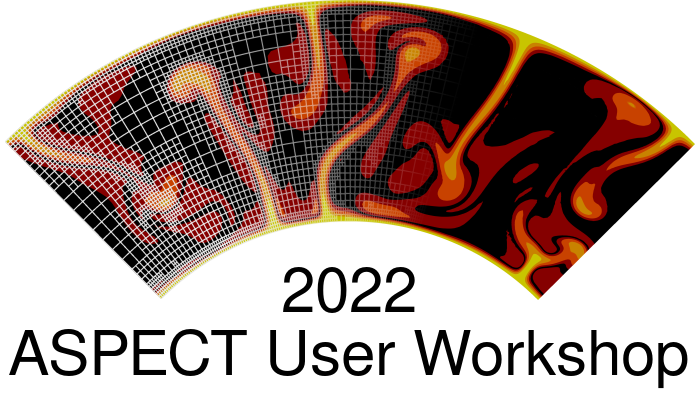
On January 19th and 20th, ASPECT had it’s annual virtual user workshop. With more than 60 participants, the virtual workshop has grown quite a bit since it started in 2020. This two day world-wide virtual event was full of great developments and showing exiting new applications in which ASPECT is being used. I will give here a short summary of the topics which where presented and discussed, and point to you the location where the recorded talks and slide can be found if you want to know more!
Besides the keynotes and short presentations, the workshop also contained discussion on the future direction of ASPECT and time for to help individuals with technical or modelling questions. In this post, I will focus on the keynote and short presentations since they where recorded, but if you have questions about ASPECT you can always make a post on the forum, create a github issue or just drop by on the bi-weekly ASPECT user meeting. The playlist with the recordings can be found here.
Since the recordings are available, I will focus on what what shown and discussed, and hope you will go and watch the talks for yourself.
Day 1
Keynote 1: Renaming ASPECT’s main branch (Rene Gassmoeller)
It was quite a technical start of the workshop, but this was a change which affects every user and developer, so it needed to be done when there where as many users and developers together so that any issues could be worked out directly. I won’t go into details why this change was and why it was needed since Rene’s provided an excellent explanation during this talk. In the end the change went over very smoothly and we haven’t encountered any major issues with the transition since.
Short presentations
Plate boundary evolution with damage memory (Erin Heilman)
Erin showed her work of implementing damage rheology into ASPECT. She shows both the implementation and the results in convection models of using this rhelology for both 2D and 3D models.
Magma-assisted flexure in Hawaiian Lithosphere (Daniel Douglas)
Like the title suggest, Daniel discussed his work on the Hawaiian lithosphere. The research is driven by the question why the Hawaiian lithosphere appears to be so weak. Does it have to do with rheology data derived from laboratory experiments, or could other explanations fit the daa better?
Deglaciation-enhanced mantle CO2 fluxes at Yellowstone imply positive climate feedback (Fiona Clerc)
Fiona started by explaining how the retreat of ice sheets can increase melting in the mantle. This can than enhance magmantic activity at the surface. These and other effects have a impact on the CO2 fluxes. In this talk she shows models where she investigates how the retreat of ice sheets influence melt generation in the mantle.
Day 2
Keynote 2: Ongoing and Future Work on Rheology in ASPECT (Anne Glerum, John Naliboff, Robert Myhill)
This presentation was mainly an overview of the current state of the continued community effort of improving the rheology models in ASPECT. The presentation focused tectonic modelling. It showed what is currently available and what is being worked on right now.
Short presentations
The Evolution of Continental Topography at Subduction Zones (Antoniette Grima)
Antoniette started out with showing how the slab shape in subduction zones has an influence on the topography. This influence can change topography seen both in space and time. The overriding plate itself can also be heterogeneous. She shows the influence of this heterogeneity on the slab evolution.
Tomography-Based Convection and Melt Generation Beneath the Rungwe Volcanic Province, East Africa (Emmanuel Njinju)
Emmanuel talked about his research on the East African Rfit. The research is driven by the observation that the Eastern branch has a lot of flood basalts, while the western part does not. He investigates the melting in this regions through modelling.
Fault network evolution in continental rifts: surface processes and automated fault analysis (Sascha Brune)
This presentation, which was given by Sacha, showed work of several collaborators. In the first part he discusses the coupling of the geodynamical/tectonic modelling software ASPECT with the surface evolution software FASTSCAPE. In the second part he talks about how to extract faults out of continuum models.
Efficient matrix-free solvers in ASPECT (Timo Heister & Jiaqi Zhang)
Timo and Jiaqi started with discussing the difference between matrix-based and matrix-free solvers and especially what the advantages are of using matrix-free solvers for our geodynamic simulations. They showed their progress in implementing it for ASPECT (and DEAL.II) and how to use it.
On the choice of finite element for applications in geodynamics (Cedric Thieulot)
Geodynamic codes have been using many different elements to construct their Finite Elements Models. Cedric discusses the advantages and disadvantages of the different elements, but also really nicely introduces those different elements.
Using Lower Mantle slab sinking rates to constrain whole mantle convection. (Erik van der Wiel)
Erik has been working on better constraining mantle convection models. He does this through using earlier research which has shown that slabs in the mantle sink about an order of magnitude slower than the plate speeds. He show his work on models to reproduce this behavior.

Haibin Yang
do you have recorded this workshop?
Michael Pons
The meeting is available at the following link
https://youtu.be/pD5kChSiYqU?si=fuO0mRONUdlgqWEH